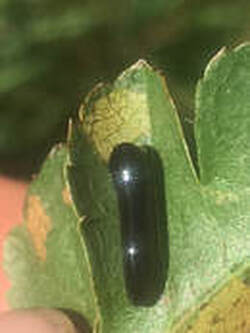 Chairman Peter Shallcross came across this 'interesting' larva at Boscombe Cutting this week. Dr John Muggleton helped with the identification: 'The black slimy grub on hawthorn is the larva of a sawfly, known as the Pear and Cherry Slugworm (Caliroa cerasi). It feeds on a number of rosaceous plants including hawthorn and, as the name suggests, pear and cherry. There are three generations a year and the larvae found at this time of the year overwinter in the soil before pupating in the Spring. They exude the slimy stuff as a form of protection - underneath is a normal sawfly larva.' Our volunteers had a new experience at our working day on 7th October. They were tasked to do an initial survey of the ‘new’ ancient woods acquired by Wiltshire Wildlife Trust up Semley Hill.
These were bought for the Trust by some very generous people of Semley and stretch for a mile to the North side of the road to Shaftesbury. They were originally given to the Arundell family by Queen Elizabeth I in 1572 and have remained with that family until now. They are on an extremely steep slope so not suitable for farming and have common rights which allow 10 landholders of Semley parish to access them. Originally this would have been for livestock and probably rights to take fallen wood. These common rights still stand so it means the woods will never have permanent fences around them. The Trust is also acquiring two areas of SSSI (site of special scientific interest). One is Gutch Common itself, where there are dormice, and the other is the steep woodland up to Castle Rings, an Iron Age earthwork at the top of the hill which was later occupied by the Romans. In all they will own over 100 acres of woodland including Oysters Coppice. It is fortunate that we now have a large number of enthusiastic and knowledgeable volunteers to help manage these woods for the Trust. On 7th October the group spread out and recorded mammal signs, notable trees, invasive species (none) and fly tipping. On the positive side there was plenty of evidence of badgers and foxes and even evidence of dormice in the hazel copse. There were plenty of veteran and notable trees - mainly oak but also holly, beech and sycamore. There were many signs of old quarries which may have been worked by the Romans as they are below the old Castle Rings fort. It would be interesting to get an archaeology survey done at some later time. The negative side was a large amount of fly-tipping covering the area. This will have to be cleared to try and prevent further fly-tipping. There was also a sizeable ‘bivvy’ that had obviously been occupied during the summer and signs of mountain biking. The Trust has also benefited from a generous grant from The Banister Charity towards the purchase of the two SSSI’s. However they still have to raise £20,000 to cover legal and administrative costs so if anyone should feel passionate about protecting our special ancient woodlands look at the following link: https://www.wiltshirewildlife.org/Appeal/gutchcommon This is a video kindly made by Ed Bersey a Trust member, to appeal for donations. For further information on volunteering or about the new woods please use our contact form. |
Photo: Avocets (Izzy Fry)
The headers display photos taken by our members. Do get in touch via the Contact Form if you'd like to submit a photo for selection.
Archives
May 2024
Categories
All
|

 RSS Feed
RSS Feed